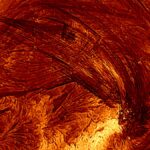It was 4 a.m. on July 4 at Camp La Junta in Kerr County when Kolton Taylor woke up to the sound of screaming. The 12-year-old boy stepped out of bed and straight into knee-deep floodwaters from the nearby Guadalupe River. Before long, the water had already risen to his waist. In the darkness, he managed to feel for his tennis shoes floating nearby, put them on, and escape to the safety of the hillside. All 400 people at the all-boys camp survived, even as they watched one of their cabins float away in the rushing river. But 5 miles downriver at Camp Mystic, 28 campers and counselors were killed.
The flash flooding in Texas would have been catastrophic at any time of day, but it was especially dangerous because it happened at night. Research shows that more than half of deaths from floods happen after dark, and in the case of flash floods, one study put the number closer to three-quarters. Other hazards are more perilous in the dark, too: Tornadoes that strike between sunset and sunrise are twice as deadly, on average, as those during the day. No one can stop the sun from rising and setting, but experts say there are simple precautions that can save lives when extreme weather strikes at night. As climate change supercharges floods, hurricanes, and fires, it’s becoming even more important to account for the added risks of nocturnal disasters.
Stephen Strader, a hazards geographer at Villanova University, said that at night, it’s not enough to rely on a phone call from a family member or outdoor warning sirens (which Kerr County officials discussed installing, but never did). The safest bet is a NOAA radio, a device that broadcasts official warnings from the nearest National Weather Service office 24/7. One major advantage is that it doesn’t rely on cell service.
“That’s old school technology, but it’s the thing that will wake you up and get you up at 3 a.m.,” said Walker Ashley, an atmospheric scientist and disaster geographer at Northern Illinois University.
Even with warning, reacting in the middle of the night isn’t easy. When people are shaken awake, they’re often disoriented, requiring additional time to figure out what’s happening before they can jump into action. “Those precious minutes and seconds are critical a lot of times in these situations for getting to safety,” Strader said.
The darkness itself presents another issue. People tend to look outside for proof that weather warnings match up with their reality, but at night, they often can’t find the confirmation they’re looking for until it’s too late. Some drive their cars into floodwaters, unable to see how deep it is, and get swept away. It’s also harder to evacuate—and try to rescue people—when you can barely see anything. “I invite anybody to just go walk around the woods with a flashlight off, and you find out how difficult it can be,” Ashley said. “Imagine trying to navigate floodwaters or trying to find shelter while you’re in rushing water at night with no flashlight. It’s a nightmare.”
The logic applies to most hazards, but the night problem appears the worst with sudden-onset disasters like tornadoes and earthquakes—and the early-morning flash floods in Texas, where the Guadalupe rose 26 feet in 45 minutes. A warmer atmosphere can hold more moisture, meaning that storms can dump more water more suddenly than they used to.
“We have essentially, because of climate change, put the atmosphere on steroids,” Strader said. It’s on his to-do list to study whether other disasters, like hurricanes and wildfires, are deadlier at night.
When Hurricane Harvey pummeled Texas with rain for days in 2017, people described waking up to water creeping into their homes; the Texas National Guard navigated rescue boats through neighborhoods in the dark, searching for survivors. In recent years, hurricanes have rapidly intensified before making landfall, fueled by warmer ocean waters. That shrinks the window in which forecasters can warn people a strong storm is coming. To compound the problem, at the end of July, the Pentagon plans to stop sharing the government satellite microwave data that helps forecasters track hurricanes overnight, leaving the country vulnerable to what’s called a “sunrise surprise.”
While daytime tornado deaths have declined over time, nighttime fatalities are on the rise, Strader and Ashley have found in their research. (It’s still unclear as to how climate change affects tornadoes.) They found that tornadoes that touch down at night are statistically more likely to hit someone, simply because there are more potential targets scattered across the landscape. During the day, people are often concentrated in cities and sturdy office buildings versus homes, which may be manufactured and not as structurally resilient to floods or high winds.
Night adds dimensions of danger to many types of disasters, but the darkness isn’t the only factor at play—and it doesn’t have to be as deadly, Ashley said, stressing the importance of getting a weather radio and making a plan in case the worst happens. “Have multiple ways to get information, and your odds of survival are extremely high, even in the most horrific tornado situation.”
This article originally appeared in Grist at https://grist.org/extreme-weather/the-surprising-reasons-floods-and-other-disasters-are-more-deadly-at-night/. Grist is a nonprofit, independent media organization dedicated to telling stories of climate solutions and a just future. Learn more at Grist.org.
Read the full article here












